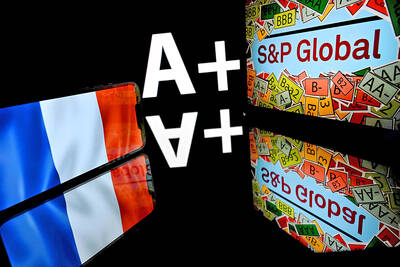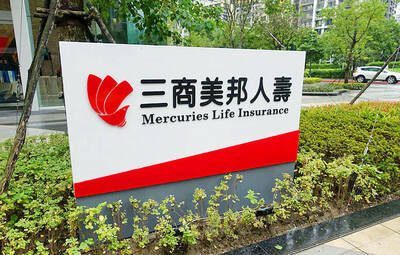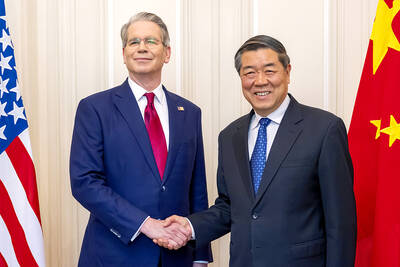Starbucks Corp's earnings estimates were reduced by two analysts after the largest US specialty-coffee retailer's June sales missed forecasts. The company's shares fell 6.6 percent.
Merrill Lynch & Co's Scott Waltmann shaved a penny off his profit forecast for this year, bringing it to US$0.46. Lehman Brothers analyst Mitchell Speiser cut his estimate US$0.02, to US$0.56. Starbucks earned US$0.35 in the year ended Oct. 1, excluding non-cash investment losses.
Sales rose 19 percent to US$259 million last month, Starbucks said yesterday. The company had forecast sales to increase 20 percent to 25 percent each month in the second half, analysts said.
It was the third straight month of shortfalls, suggesting new stores aren't doing as well as expected and sales to businesses also are slow, analysts said.
"If it was one or two months, it would be one thing, but when it's three months, it starts to raise red flags," said Waltmann, who reduced his rating on Starbucks to near-term "neutral" from near-term "accumulate."
"You have to question what factors they are looking at to drive revenue growth."
Shares of Starbucks fell US$1.44 to US$20.48. The stock has declined 7.4 percent this year.
Starbucks's sales are getting hurt by a slowdown in consumer spending and job cuts across the country that are making consumers more wary of spending, analysts said. At such a time, Starbucks has less flexibility to raise prices to improve profit, they said.
The company in August raised coffee-drink prices US$0.05 to US$0.10.
Sales at company-owned stores open at least a year rose 3 percent in June, Seattle-based Starbucks said. So-called same-store sales are an important retail measure because they exclude new or closed locations.
Analysts surveyed by First Call/Thomson Financial forecast Starbucks will earn US$0.46 this fiscal year and US$0.57 a share next year.
Waltmann cut his estimate for next year by a penny, to US$0.57.
Starbucks has more than 4,400 locations in North America, Europe, the Middle East and Asia. The most rapid expansion for the chain is in Australia, while it plans its first oulet in Austria this year.

France cannot afford to ignore the third credit-rating reduction in less than a year, French Minister of Finance Roland Lescure said. “Three agencies have downgraded us and we can’t ignore this cloud,” he told Franceinfo on Saturday, speaking just hours after S&P lowered his country’s credit rating to “A+” from “AA-” in an unscheduled move. “Fundamentally, it’s an additional cloud to a weather forecast that was already pretty gray. It’s a call for lucidity and responsibility,” he said, adding that this is “a call to be serious.” The credit assessor’s move means France has lost its double-A rating at two of the

AI BOOST: Although Taiwan’s reliance on Chinese rare earth elements is limited, it could face indirect impacts from supply issues and price volatility, an economist said DBS Bank Ltd (星展銀行) has sharply raised its forecast for Taiwan’s economic growth this year to 5.6 percent, citing stronger-than-expected exports and investment linked to artificial intelligence (AI), as it said that the current momentum could peak soon. The acceleration of the global AI race has fueled a surge in Taiwan’s AI-related capital spending and exports of information and communications technology (ICT) products, which have been key drivers of growth this year. “We have revised our GDP forecast for Taiwan upward to 5.6 percent from 4 percent, an upgrade that mainly reflects stronger-than-expected AI-related exports and investment in the third

Mercuries Life Insurance Co (三商美邦人壽) shares surged to a seven-month high this week after local media reported that E.Sun Financial Holding Co (玉山金控) had outbid CTBC Financial Holding Co (中信金控) in the financially strained insurer’s ongoing sale process. Shares of the mid-sized life insurer climbed 5.8 percent this week to NT$6.72, extending a nearly 18 percent rally over the past month, as investors bet on the likelihood of an impending takeover. The final round of bidding closed on Thursday, marking a critical step in the 32-year-old insurer’s search for a buyer after years of struggling to meet capital adequacy requirements. Local media reports

RARE EARTHS: The call between the US Treasury Secretary and his Chinese counterpart came as Washington sought to rally G7 partners in response to China’s export controls China and the US on Saturday agreed to conduct another round of trade negotiations in the coming week, as the world’s two biggest economies seek to avoid another damaging tit-for-tat tariff battle. Beijing last week announced sweeping controls on the critical rare earths industry, prompting US President Donald Trump to threaten 100 percent tariffs on imports from China in retaliation. Trump had also threatened to cancel his expected meeting with Chinese President Xi Jinping (習近平) in South Korea later this month on the sidelines of the APEC summit. In the latest indication of efforts to resolve their dispute, Chinese state media reported that